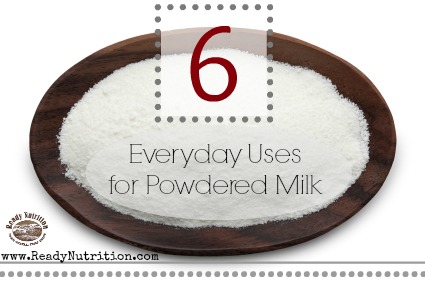Powdered milk… I know what many of you are thinking, “Never in a million years will I substitute dry milk for the real thing.” Up until a few years ago, I was right there with you, but I have since seen the light. Let me begin by saying powdered milk has gotten a bad rap.
Powdered milk is a prepper staple that all prepper sites suggest we stock up on. To calculate how much your family needs, click here. Bear in mind that if you have small children or are a nursing mother, it is important to have even more powdered milk stored.
Not many know of the versatility of the nutritional value of our little powdered friend. One cup of dry milk provides you with a good source of protein, vitamins A and D, calcium, magnesium and essential fats.
To reconstitute dry milk:
To reconstitute one quart nonfat milk, sprinkle ¾ cup (3.2 oz) non-instant dry milk powder on top of 3¾ cups water at
room temperature. Beat with mixer, rotary beater or wire whip until dissolved.
To reconstitute one gallon nonfat milk, sprinkle 3 cups (12.8 oz) non-instant dry milk powder on top of 3 qt 3 cups
water at room temperature. Beat with mixer, rotary beater, or wire whip until dissolved.
Tips on preparing powdered milk:
- Mix it very well. Using a clean egg beater or mixer helps to break up the clumps.
- Mix powdered milk with very cold water. When mixed, keep it very cold.
- Make powdered milk the night before use. This helps the flavor come out.
- Mixing equal parts of fresh milk to reconstituted milk to help ease fussy drinkers.
- A little sweetener can go a long way. Adding a spoonful of sugar, chocolate syrup or vanilla extract can help enhance the flavor.
- If your family still doesn’t like the taste of reconstituted milk, use it for cooking purposely only and save your real milk for drinking.
For those of us trying to find more economical ways to deal with the ever-increasing grocery bill, powdered milk is your best friend! Many of our diets are centered around dairy products: milk, cheese, sour cream, coffee creamer, and heavy cream. All of these products can be made with powdered milk!
Storing powdered milk:
According to USA Emergency Supply, “Dry milk products are probably the most sensitive to environmental conditions storage foods there are, particularly to temperature and moisture content. Their vitamins A and D are also photosensitive and will break down rapidly if exposed to light.
The area where your dry milk is stored should be kept as cool as possible. If it is possible to do so, air-conditioning or even refrigeration can greatly extend the nutrient shelf life. After opening a package of dry milk, transfer the powder to a tightly covered glass or metal container (dry milk can pick up odors from plastic containers) and keep it in the refrigerator. Unsealed nonfat dry milk keeps for a few months; dry whole milk for a few weeks.
For long term storage, my family stores powdered milk in sealed Mylar bags. Adding desiccant pouches to minimize moisture will also prevent “lumping” in the powdered milk. Once opened, we store the unused powdered milk in the refrigerator for prolonged freshness. Use the instructions outlined in this article to store powdered dry milk in Mylar bags.
Aside from using powdered milk as a substitute for the real thing, there are other ways that you can use this essential pantry item when cooking. The following are just a few of the recipes found in The Prepper’s Cookbook: 365 Recipes to Turn Your Emergency Food into Nutritious, Delicious, Life-Saving Meals.
Sweetened Condensed Milk Recipe
Equivalent to 14 ounce can
- 1 tablespoon butter
- ½ cup hot water
- 1 cup nonfat dry milk
- ¾ cup sugar
- In a small saucepan, add the butter in the hot water and stir until combined.
- Pour into a bowl and stir in the dry milk powder and sugar. Mix well until the sugar and milk powder are dissolved.
Evaporated Milk Recipe
Equivalent to 12 oz. can
- 1 1/3 cups water
- 1 cup nonfat instant dry milk
- Place the ingredients in a jar with a tight fitting lid and shake vigorously.
Hot Cocoa Mix
Makes 6 cups
Ingredients:
- 2 c. dry milk powder
- ½ c. non-dairy creamer
- ¾ c.zj sugar
- ½ c. cocoa
- Dash of spice such as cinnamon, nutmeg or cayenne or pepper
- Mix all ingredients together and store in a cool, dry space.
- To make drink, add 1 cup of warm milk or water to 1-2 tablespoons of cocoa mixture.
Heavy Cream Substitute
- 1 cup milk
- ¼ cup nonfat dry milk
- Whirl the milk and dry milk powder in a blender until thoroughly mixed. Use in baking or cooking dishes that call for heavy whipping cream.
Instant Oatmeal Mix
- 6 cups quick-cooking oats
- 1/3 cup dry powdered milk
- 1/4 cup powdered sugar
- 1/4 cup packed brown sugar
- 3 teaspoons ground cinnamon
- 1 teaspoon salt
- 1 cup dried fruit or nuts
- In a large bowl, combine all of the above ingredients. Then store in airtight container in a cool dry place for up to 1 month.
To prepare oatmeal:
- Place 1/2 cup of mix and add 1/2 cup boiling water or milk to the mix and stir until oats are softened, about 2-3 minutes.
Pudding Mix
Serves 4
- 3 cups nonfat dry milk
- 1 3/4 cups granulated sugar
- 1 cup cornstarch
- 1/4 teaspoon salt
- Stir all the ingredients together until well blended. Store in a covered container or in individual 1-cup packages.
- To make pudding, place 1 cup pudding mix in a small saucepan. Slowly sir in 2 cups boiling water. Cook over medium heat for 3 to 5 minutes, stirring constantly, until the mixture is thickened. Let the mixture cool slightly and then pour into individual containers to make homemade pudding cups or into a single container. Cover and keep refrigerated.
Vanilla pudding—Stir in 1 teaspoon vanilla extract and 1 tablespoon butter once the pudding has thickened.
Chocolate pudding—Add 2 tablespoons of cocoa powder to 1 cup of dry mixture before cooking. Stir in 1/2 teaspoon vanilla and 1 tablespoon butter once the pudding has thickened.
*Place plastic wrap on top to prevent a skin from forming – me, I love pudding skin, but maybe I’m weird. Cool for 15 minutes till room temp and then spoon into individual bowls if you want, refrigerate for at least an hour.





